I tried to write this post from the last leg of my trip, between Utica, NY and Pittsfield, MA. I’ve been dictating posts as I go, recording on my iPhone and transcribing using MacWhisper, a Mac port of the OpenAI large language model used to transcribe YouTube videos. Weirdly, Whisper has been getting worse as I’ve used it – perhaps Amy’s car is noisier than mine and that makes transcription harder. But this time around, the transcription failed entirely – large chunks of the output are just a single phrase repeated over and over: “I’m going to pick up some of the items that I have. I’m going to pick up some of the items that I have. I’m going to pick up some of the items that I have. I’m going to pick up some of the items that I have. I’m going to pick up some of the items that I have. I’m going to pick up some of the items that I have. I’m going to pick up some of the items that I have. I’m going to pick up some of the items that I have. I’m going to pick up some of the items that I have. I’m going to pick up some of the items that I have.” So forgive the delay in posting this – I’ve had to write it from scratch, treating the recording as field notes
Here’s what I was picking up in Utica, a city about two hours from home, with great ethnic grocery stores and a big Balkans population: white cheese (like feta, but denser and creamier, in a salty brine), soujouk (fermented beef sausage) and cheese beurek, which I keep in the freezer for the days I don’t want to cook. As a treat, I picked up a few slices of tomato pie, a unique Utica delight – it’s pizza dough topped with a rich tomato sauce and a light sprinkling of parmasean cheese. The girl behind the counter wanted me to buy a pizza instead, promising I would be disappointed, and finally settled for selling me three slices for $2 total. I was not disappointed. I rarely am in Utica.
Utica is the place that cemented my fascination with undervalued cities. I get to watch Pittsfield change day to day, week to week, which is great for seeing change on the micro scale. But I tend to visit Utica every few months, which gives me a different awareness of how migration might transform undervalued cities for the better.
As described in Susan Hartmann’s excellent “City of Refugees”, Utica’s identity the past few decades is that of a city transformed by its immigrant population. 22.2% of the city’s 64,000 people were born outside of the US, below immigrant meccas like Miami, but way above the national rate of 13.7%, and very high for a small city. Utica began resettling refugees in the wake of the Vietnam war, providing housing for Amerasians who were discriminated against in Vietnam. A huge wave of Bosnian resettlement during the Yugoslav wars turned Utica into a city with a strong Muslim population, halal markets and several mosques. That may have made it a popular destination for Rohingya Muslims, fleeing ethnic cleansing in Myanmar… and their success may have attracted other minority groups in Myanmar like the Karen. Recently, we’re seeing Somali Bantus, darker-skinned Somali Muslims whose ancestry comes from southern Africa, and who have been fleeing violence in southern Somalia, often ending up in the Dadaab refugee camp on the Somali/Kenyan border.
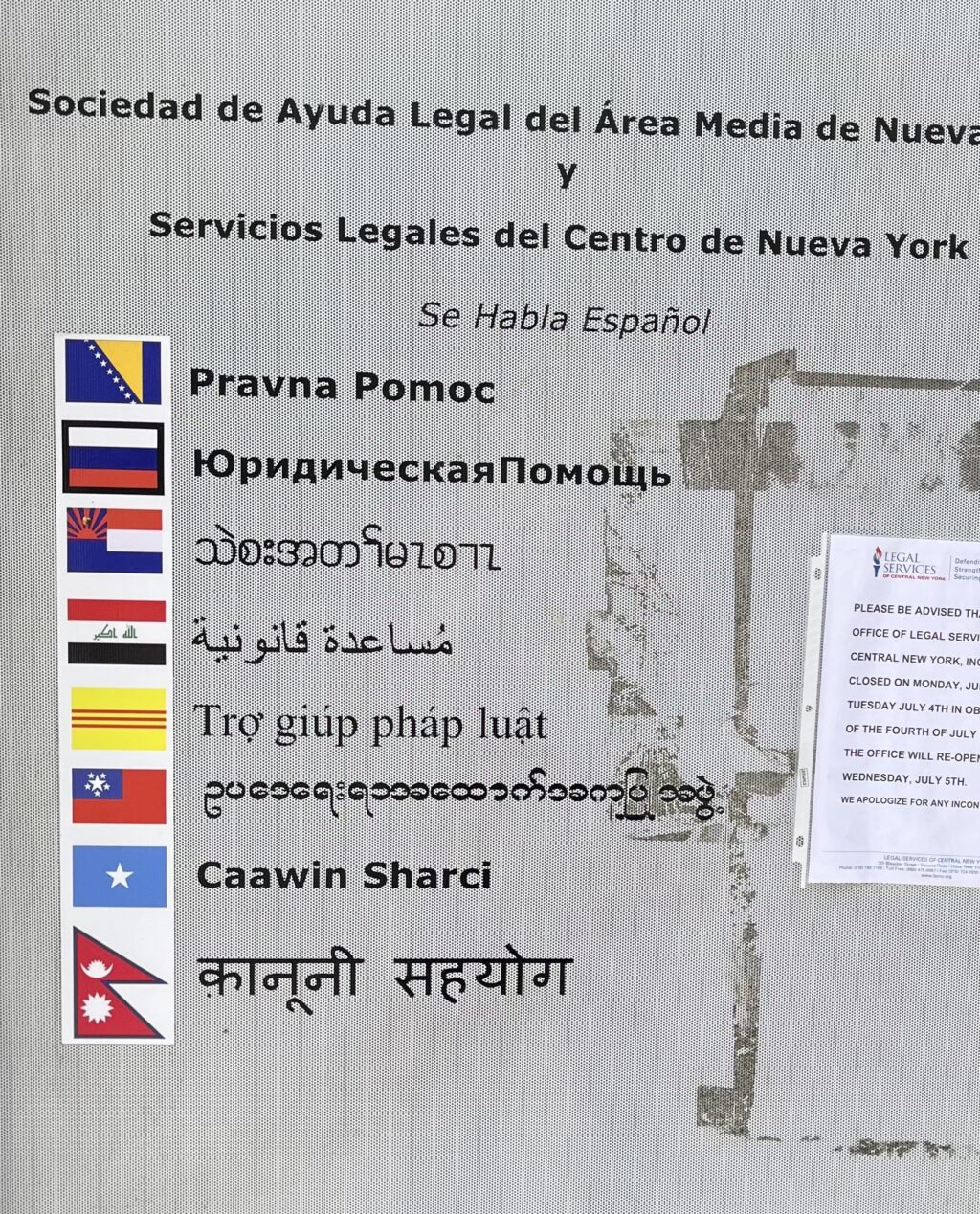
From the door of the Central New York legal services center. How many languages can you identify?
In the “favorites” album on my phone, I keep a picture of a sign on the door of the Utica legal aid society – it welcomes speakers of English, Spanish and 8 other languages. I often challenge my world-travelling cosmopolitan friends to identify all eight flags and scripts of the languages the office regularly provides service in.
I picked up my tomato pie on Bleecker Street, historically the home of Utica’s Italian immigrant population. The pizzeria was founded in 1914, and some of the buildings on the street have likely hosted Italian bakeries and similar businesses for the last decade. The Italian American club is now defunct, and many of the stores are now markets aimed at West African, Burmese and Iraqi clients, with a healthy strain of Dominican fried chicken restaurants thrown in. Burmese restauranteurs have been making inroads in the city for years, but the most popular has been Nanabi, which offers “Asian fusion”, not uncommon for Burmese chefs who understand that Japanese and Korean food are better known than their traditional cuisine. But Black Rice, which started as a sushi bar, appears to be leaning into its Burmese identity, as well as offering the fried chicken that seems to be Utica’s universal language.
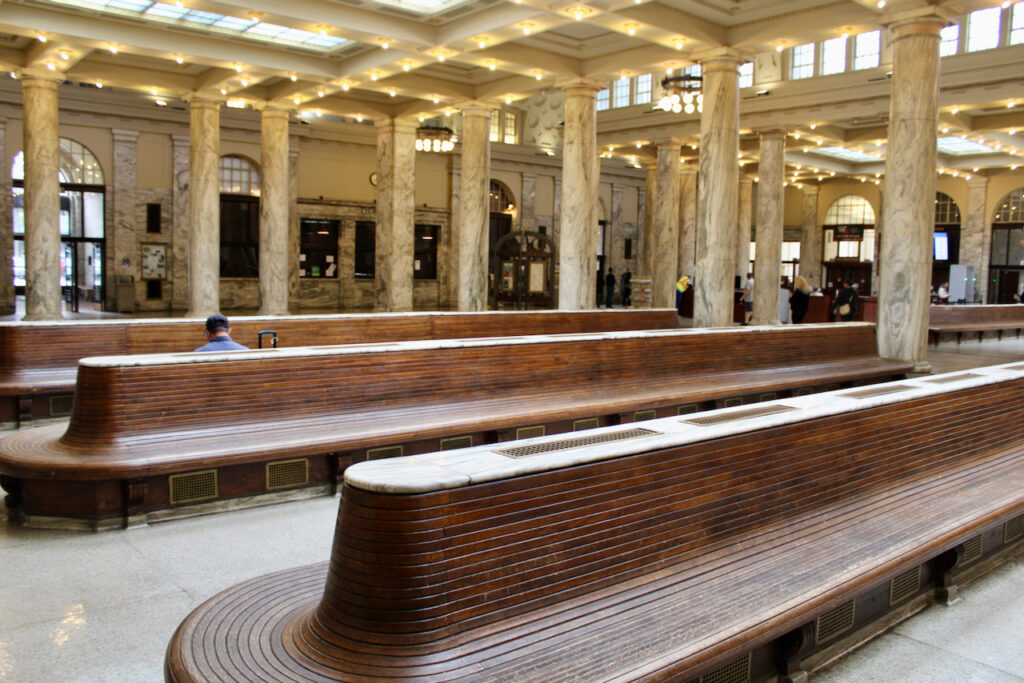
Inside Utica’s Union Station
Walking towards the railroad tracks, I got a sense for how Utica is transforming what it has into what it needs. Not only are Italian bakeries becoming Dominican mercados, and churches being transformed into mosques, but Utica’s magnificent Union train station has returned to life in an impressive set of pragmatic decisions. Amtrak still serves Utica, but with only four trains a day, and a scenic railway offers weekend beer, wine and dinner trains, but it’s easy to imagine the vast station as empty and foreboding much of the time. So Utica got creative – the Department of Motor Vehicles now occupies about a third of the waiting room, creating foot traffic as people complete necessary government business. The public defender’s office is upstairs, and other amenities – a barber shop, a ticket counter for Greyhound buses – give the place some vibrancy that many stations lack.
Maybe most surprising to visitors to Utica is Tailor and the Cook, an award-winning farm to table restaurant that’s between Union Station and the historic Baggs Tavern, which has hosted George Washington, Henry Clay and Ulysses S. Grant. I’ve not been – it’s outside the price range of this sort of ramble – but it’s exciting that such a business, or Utica Bread just down the street, can thrive alongside businesses supporting those who’ve recently arrived to the city and this country.
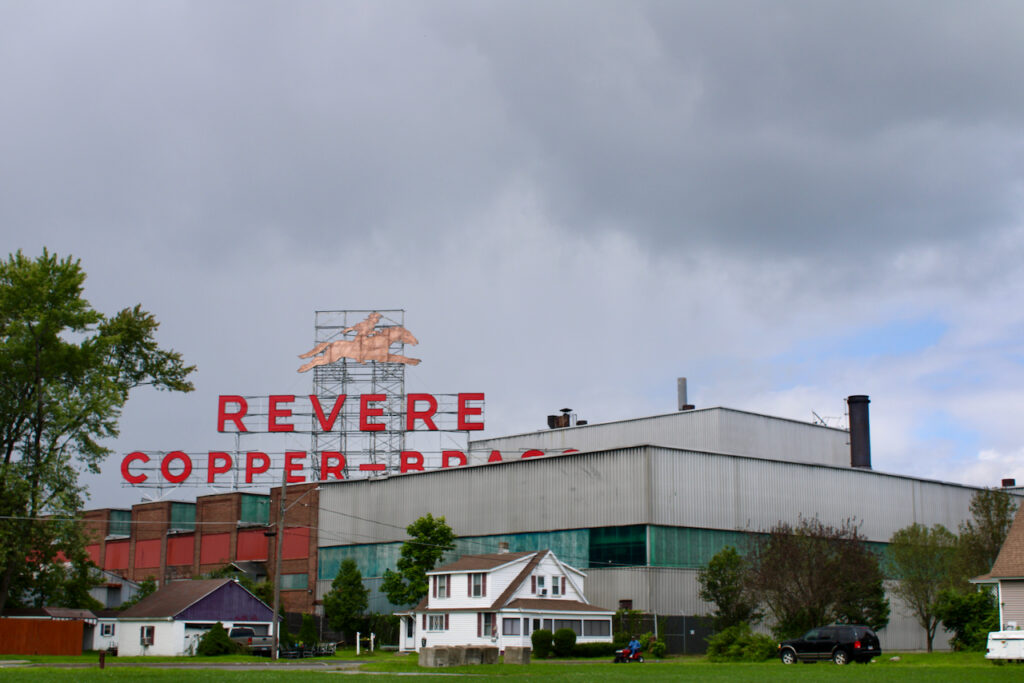
The Revere Copper and Brass factory, Rome, NY
I visit Utica every few months, but I spend much less time in Rome, New York. It’s a sister city about a dozen miles away and, unfortunately, it’s a city that’s much harder to feel hopeful about. Like Utica, it’s lost population due to deindustrialization, and unlike some of the other cities on the trip transforming while retaining their historical identities (looking at you, Glass City and Salt City), the Copper City is having a tough time turning the corner. Abandoned buildings are being condemned and torn down, and you can already see streets with “missing teeth”, buildings that have been demolished and become grass lots. To further complicate matters, a tornado hit the city some weeks ago and two 19th century churches lost their steeples and roofs. It’s not clear whether it’s going to be possible to rebuild, as the shrinking population also means a shrinking tax base.
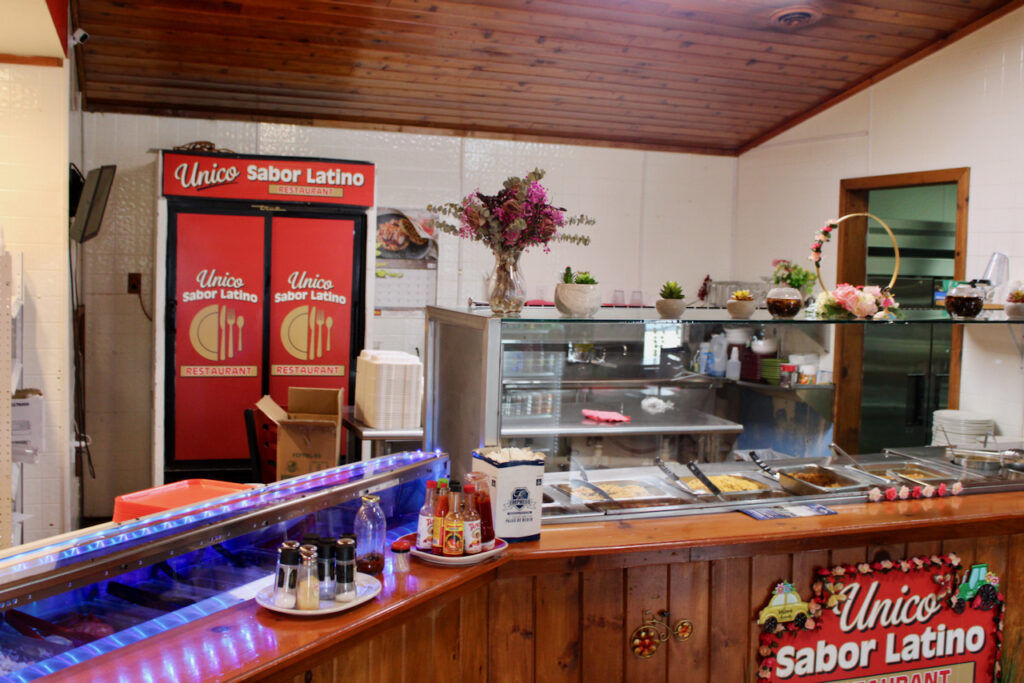
Sabor Latino, an excellent Dominican restaurant in Rome, NY
I have a fairly strict rule about patronizing local businesses rather than chains when I visit cities on a trip like this, but it was hard to even find a non-chain cup of coffee in downtown Rome. I had lunch at the top-rated restaurant in town, an excellent Dominican steam-table place (I recommend the oxtail), and there’s a few businesses on the edge of the historic city, but I found it hard to imagine a turnaround any time soon.
But then again, there’s always Syracuse. The city is often cited as one of the most segregated in the US, and one of the most profoundly affected by the US interstate system and the ways it displaced communities of color. When I-81 was built in the 1960s, it ran right through the 15th ward, where 90% of Black residents of Syracuse lived, and displaced 1300 families. That neighborhood has had significant health, education and infrastructural issues since. Officials have recently agreed to tear down the interstate and reconnect the 15th ward to the grid, routing high-speed traffic around the city on an expanded I-481. Nearby Rochester, NY has removed its “inner loop” and become a national model for rebuilding neighborhoods in the space that is reopened.
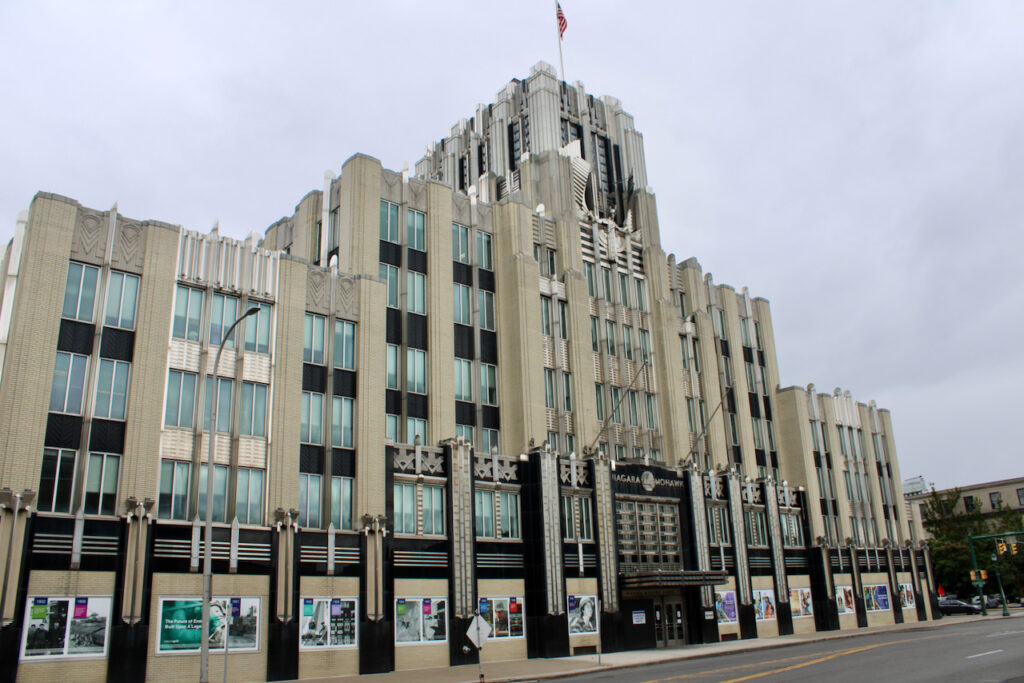
The art-deco Niagara Mohawk building in Syracuse, NY
Between the racial history of Syracuse and a talk I gave at the university some years back that no one bothered to promote, I’ve sometimes had a chip on my shoulder about the Salt City. But the point of this trip was to make the case that every undervalued city has something delightful about it, and it wasn’t hard at all to find that in Syracuse. Even on a rainy Tuesday morning, the city was lively and busy around the farmers’ market, with fresh vegetables and handmade tamales on offer. I had breakfast in excellent coffee shop that’s made great use of bizarre hangar-like building run by proprietors who clearly know their neighbors, correctly anticipatingpeople’s breakfast and lunch orders. The city itself is beautiful with a wealth of early 20th century architecture, and I was hoped in my appreciation of it by an unhoused man who pointed me to the local peregrine falcon population. (We have peregrines at UMass, and I love those remarkable creatures.)
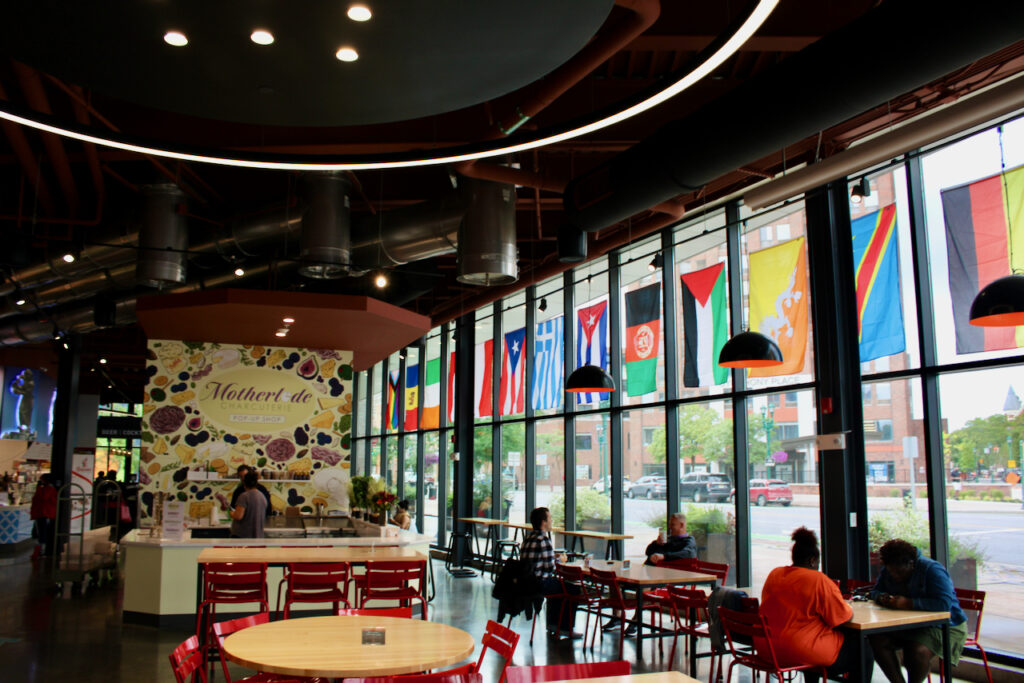
Maybe the most exciting feature of downtown Syracuse for me is Salt City Market, a food hall that’s anchoring downtown revival. This is a strategy that I’ve seen across upstate New York – the first I encountered was in Buffalo, where West Side Bazaar provided market stalls and kitchen space to incubate immigrant entrepreneurs. That building burned in September 2022, but the project has relocated to a bright and beautiful new space. Nearby Troy, NY has a foodhall that’s making some progress, and I encountered a great, small foodhall in Erie, PA earlier on the trip, which offere Dominican food alongside more familiar selections like tacos and sushi.
Syracuse takes the urban foodhall to a different level. There’s a cooperative grocery store, a space for pop-ups, one now occupied by a cake shop the other by a charcuterie, and restaurant spaces occupied by Jamaican, Dominican, Mexican, Ethiopian, and several other cuisines. Well before noon, the place was humming and it felt thoughtfully put together and well loved by the community.
That sense of being well-loved is a theme that’s caught in my head as I try to process this trip as a whole. With 2900 miles of driving, 69 hours behind the wheel and 24 cities visited, it’s hard to generalize across incredible variation. But if there’s an overarching idea, it’s that it’s easy to see when someone cares for a place.

I started my discussion of undervalued cities with a picture of one of the small murals that’s beautified my native Pittsfield, MA, and I’ve snapped photos of murals all throughout my travels. They call attention to parts of a city we might otherwise forget, and I have yet to see a mural that didn’t positively impact the building that hosted it. I can’t really find a downside to murals – in Syracuse, I saw a stretch of railroad track that someone had decorated 10 or 20 years ago. The colors are fading, but there’s still the reminder that someone paired enough about this spot to show us some love and care.
The opposite, of course, is storefronts that are boarded up or worse, abandoned. Something Toledo did very well was cover unoccupied storefronts with a thin scrim presenting the various different uses these buildings might be put to. There’s a similar visual appeal to painting the boarded up stores to make them look as they might before windows were broken and covered over, but the message of the boards is clear: this isn’t changing anytime soon. I’m a bigger fan yet of the stores that put art in the windows, in the hopes of beautifying a hole in the landscape while waiting for the next tenant to care for the space.
Shrinking cities are a difficult trap, where declining population means fewer resources to care for decaying infrastructure. Rome, NY, Youngstown, OH and Gary, IN all felt like cities that might not make it through the transformation that other cities are benefitting from. I am confident there are people who love these places as fiercely as anyone loves Akron, Peoria or Toledo… but some holes are harder to fill than others. Wherever a city is in its path towards recovery, you can see the love if you look hard enough.
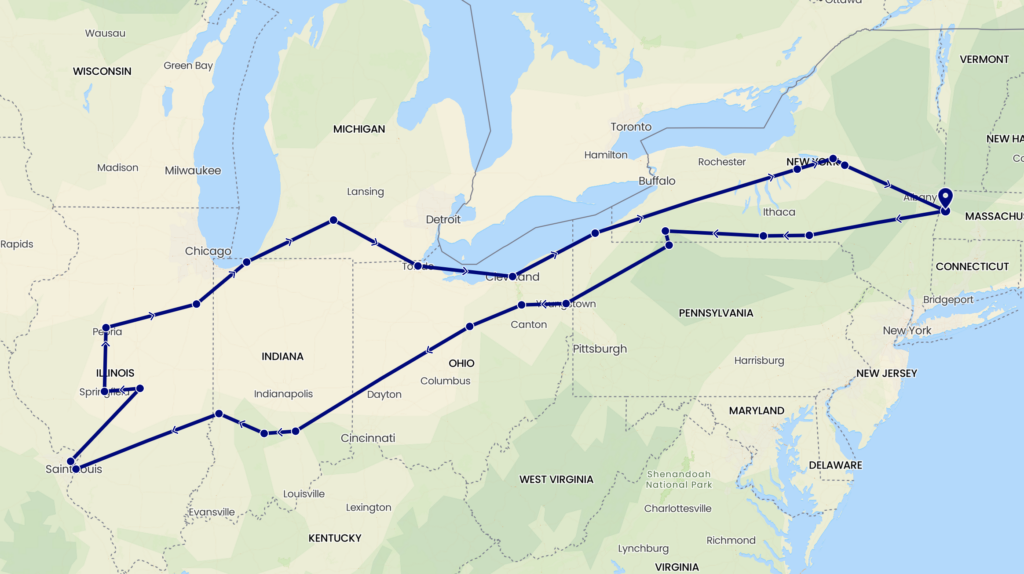
A rough outline of the route followed, with no consideration of the actual highways and routes involved.
This is the last post chronologically on my summer 2024 trip, but there’s at least two more posts coming from earlier in the journey. There’s a long post about Gary, Indiana and Toledo, OH that needs editing, and a post I hope to write about Columbus, Indiana (with a brief detour to Terre Haute) that needs research before I can share it. There’s likely more to come as well – I’ve got more questions than answers as I digest two weeks of cities and experiences.
I close with a personal note. A few days back, I called Amy, worried that I had somehow turned my summer vacation into something stressful, spending 12 – 14 hours a day walking, driving, photographing and exploring these new places, then spending my hotel nights editing blog posts. What does it mean that I’m able to turn two weeks of leisure into an all-consuming writing project.
Amy told me that she never thought of this as a vacation, but as a research trip. “Okay, but how am I going to engage in self-care before the semester starts,” I asked. “You’ll know it’s self-care if you feel better after you do it.” Wise woman, that Amy Price.
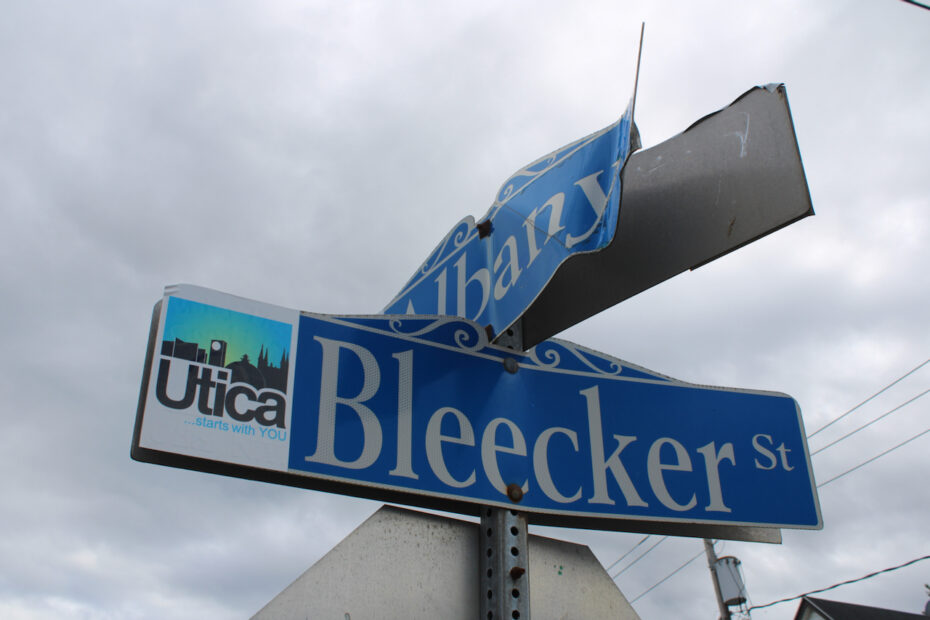
Wise woman indeed. :)
Pingback: Roadtrip: A tale of two cities - Ethan Zuckerman
Thanks for this! Our own exploration of Utica has been limited to trying a couple places for tomato pie – our favorite is this one: https://romasausageanddeli.com.
It’s great to get a deeper dig into the place. And I really like the focus on undervalued, but loved, cities.